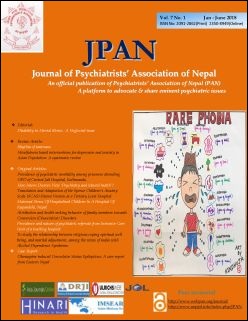Prevalence and nature of psychiatric referrals from Intensive Care Unit of a teaching hospital
DOI:
https://doi.org/10.3126/jpan.v7i1.22941Keywords:
ICU, Psychiatry, ReferralAbstract
Introduction: Patients admitted to intensive care unit (ICU) are diagnosed with various disorders. There is limited literature on the prevalence of psychiatry disorders in patients admitted to ICU. The aim of the study was toestimate the prevalence and nature of psychiatric referrals from ICU.
Material and Method: Hundred consecutive patient admitted to the ICU (both medical ICU and CCU) in Nepalgunj Medical College Teaching Hospital (NGMCTH), Kohalpur, Nepal and referred to psychiatry department were enrolled for the study. Study was conducted from October 14, 2017 to June 14, 2018. Informed consent was taken and patients were interviewed by two psychiatrists in different occasions separately and other relevant history was obtained from next of kin. Socio-demographic variables, referring department, reason for referral, purpose of referral, major symptom for referral were the major variables. Psychiatric diagnosis was made using the ICD-10. Data was analyzed using Statistical Package for the Social Sciences (SPSS) version 21.0 for Windows.
Results: During the study period the total patients admitted to the ICU was 787 among which 100 were referred to psychiatry department. Psychiatry referral rate was 7.87%, average patients referred were 2.4 per day. Psychiatry morbidity was 8.11%. The mean age was 36.87+12.81 years. Most of the patients were female, and from urban background. The most common diagnosis was alcohol use disorder (AUD) followed by intentional self harm (ISH) and delirium respectively. Organic disorder and dissociative disorder were the only disorders significantly associated (p<0.05) with the age of the patient. AUD (p=0.007) and ISH (p=0.011) was common in female compared to males and the difference was statistically significant.
Conclusion: Psychiatric referral rate and psychiatry morbidity was low.
Downloads
Downloads
Published
How to Cite
Issue
Section
License
This license enables reusers to distribute, remix, adapt, and build upon the material in any medium or format, so long as attribution is given to the creator. The license allows for commercial use.




